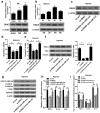miR-214 ameliorates acute kidney injury via targeting DKK3 and activating of Wnt/β-catenin signaling pathway
- PMID: 30180910
- PMCID: PMC6122444
- DOI: 10.1186/s40659-018-0179-2
miR-214 ameliorates acute kidney injury via targeting DKK3 and activating of Wnt/β-catenin signaling pathway
Abstract
Background: miR-214 was demonstrated to be upregulated in models of renal disease and promoted fibrosis in renal injury independent of TGF-β signaling in vivo. However, the detailed role of miR-214 in acute kidney injury (AKI) and its underlying mechanism are still largely unknown.
Methods: In this study, an I/R-induced rat AKI model and a hypoxia-induced NRK-52E cell model were used to study AKI. The concentrations of kidney injury markers serum creatinine, blood urea nitrogen, and kidney injury molecule-1 were measured. The expressions of miR-214, tumor necrosis factor-α, interleukin (IL)-1β, IL-6, were detected by RT-qPCR. The protein levels of Bcl-2, Bax, Dickkopf-related protein 3, β-catenin, c-myc, and cyclinD1 were determined by western blot. Cell apoptosis and caspase 3 activity were evaluated by flow cytometry analysis and caspase 3 activity assay, respectively. Luciferase reporter assay was used to confirm the interaction between miR-214 and Dkk3.
Results: miR-214 expression was induced in ischemia-reperfusion (I/R)-induced AKI rat and hypoxic incubation of NRK-52E cells. Overexpression of miR-214 alleviated hypoxia-induced NRK-52E cell apoptosis while inhibition of miR-214 expression exerted the opposite effect. Dkk3 was identified as a target of miR-214. Anti-miR-214 abolished the inhibitory effects of DKK3 knockdown on hypoxia-induced NRK-52E cell apoptosis by inactivation of Wnt/β-catenin signaling. Moreover, miR-214 ameliorated AKI in vivo by inhibiting apoptosis and fibrosis through targeting Dkk3 and activating Wnt/β-catenin pathway.
Conclusion: miR-214 ameliorates AKI by inhibiting apoptosis through targeting Dkk3 and activating Wnt/β-catenin signaling pathway, offering the possibility of miR-214 in the therapy of ischemic AKI.
Keywords: Acute kidney injury; Dkk3; Wnt/β-catenin signaling pathway; miR-214.
Figures





Similar articles
-
Inhibition of miR-155 Ameliorates Acute Kidney Injury by Apoptosis Involving the Regulation on TCF4/Wnt/β-Catenin Pathway.Nephron. 2019;143(2):135-147. doi: 10.1159/000501038. Epub 2019 Jun 19. Nephron. 2019. PMID: 31216555
-
miR-182 enhances acute kidney injury by promoting apoptosis involving the targeting and regulation of TCF7L2/Wnt/β-catenins pathway.Eur J Pharmacol. 2018 Jul 15;831:20-27. doi: 10.1016/j.ejphar.2018.05.001. Epub 2018 May 4. Eur J Pharmacol. 2018. PMID: 29733821
-
LINC00052 ameliorates acute kidney injury by sponging miR-532-3p and activating the Wnt signaling pathway.Aging (Albany NY). 2020 Nov 24;13(1):340-350. doi: 10.18632/aging.104152. Epub 2020 Nov 24. Aging (Albany NY). 2020. PMID: 33231561 Free PMC article.
-
WNT-β-catenin signalling - a versatile player in kidney injury and repair.Nat Rev Nephrol. 2021 Mar;17(3):172-184. doi: 10.1038/s41581-020-00343-w. Epub 2020 Sep 28. Nat Rev Nephrol. 2021. PMID: 32989282 Review.
-
Wnt/β-Catenin in Acute Kidney Injury and Progression to Chronic Kidney Disease.Semin Nephrol. 2020 Mar;40(2):126-137. doi: 10.1016/j.semnephrol.2020.01.004. Semin Nephrol. 2020. PMID: 32303276 Free PMC article. Review.
Cited by
-
DKK3 ameliorates neuropathic pain via inhibiting ASK-1/JNK/p-38-mediated microglia polarization and neuroinflammation.J Neuroinflammation. 2022 Jun 3;19(1):129. doi: 10.1186/s12974-022-02495-x. J Neuroinflammation. 2022. PMID: 35658977 Free PMC article.
-
The role of microRNAs in diseases and related signaling pathways.Mol Biol Rep. 2022 Jul;49(7):6789-6801. doi: 10.1007/s11033-021-06725-y. Epub 2021 Oct 31. Mol Biol Rep. 2022. PMID: 34718938 Review.
-
miR‑30a‑5p mitigates autophagy by regulating the Beclin‑1/ATG16 pathway in renal ischemia/reperfusion injury.Int J Mol Med. 2021 Jul;48(1):144. doi: 10.3892/ijmm.2021.4977. Epub 2021 Jun 3. Int J Mol Med. 2021. PMID: 34080645 Free PMC article.
-
miR-25-3p protects renal tubular epithelial cells from apoptosis induced by renal IRI by targeting DKK3.Open Life Sci. 2021 Dec 31;16(1):1393-1404. doi: 10.1515/biol-2021-0127. eCollection 2021. Open Life Sci. 2021. PMID: 35174294 Free PMC article.
-
Role of the microRNA‑214/Bax axis in the progression of acute liver failure.Mol Med Rep. 2020 Jul;22(1):117-126. doi: 10.3892/mmr.2020.11123. Epub 2020 May 5. Mol Med Rep. 2020. PMID: 32377732 Free PMC article.
References
MeSH terms
Substances
LinkOut - more resources
Full Text Sources
Other Literature Sources
Research Materials

